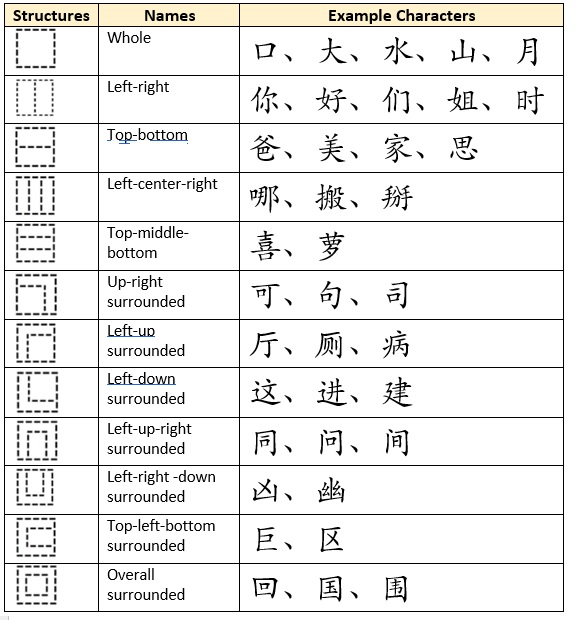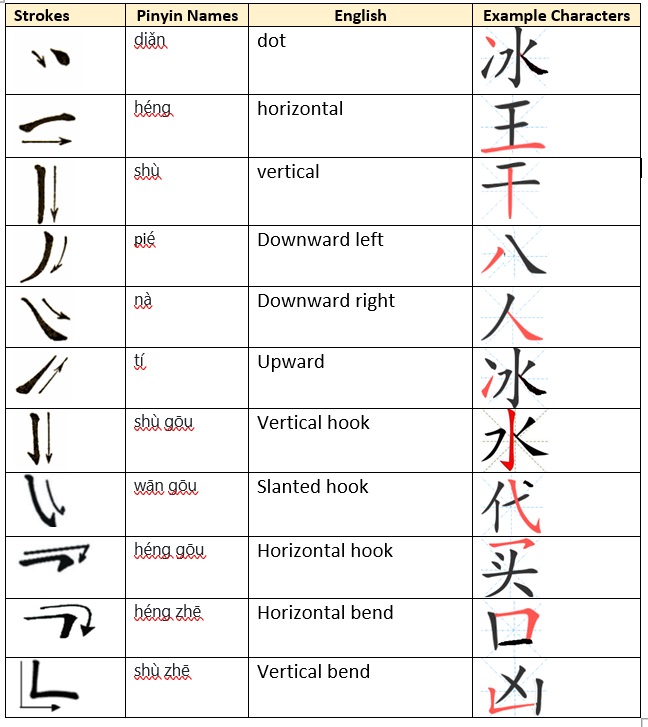4 Chinese Characters
Brief Introduction:
Chinese characters, also called Hanzi, are the oldest continuously used writing system in the world. Unlike the Roman alphabets, Chinese characters are used to illustrate meaning rather than sound. That’s why learning to read Chinese requires a lot of memorization.
There are over 100,000 different Chinese characters. It is actually impossible to count them all precisely. However, the good news is, for language learners, knowing just 2,000 to 3,000 characters will give you the tools to read most newspapers and magazines.
Character Composition:
The composition of Chinese characters follows a certain system. Most of the characters consist of two components, one phonetic component and one symbolic component (as can be found in the 2nd, 3rd, 4th, 5th, 7th, 8th, and 12th rows of the table below). The phonetic component indicates how a character is pronounced, and the symbolic component signifies the meaning of the character. For example, the character 姐 on the 2nd row consists of two components: on the left is the symbolic component “女”, meaning “female, woman”; on the right is the phonetic component “且”, with the pronunciation “qie”. The meaning of the character is “big sister”.
Some characters consist of three components, as listed in the 4th and 5th rows of the table below.
Some characters are single component ones, such as 口,大,水 , as listed in the first row of the table below.

Radicals:
Here is a table that lists commonly used radicals
Basic Strokes:
When learning to write Chinese characters, a good first step in making the task less intimidating is identifying strokes. A basic stroke is a single calligraphic mark moving in one direction across a writing surface. Here are some basic strokes.

Stroke Order:
Following the stroke order rules will make it easier for you to write Chinese characters. Your handwriting will also look better if you write characters in the correct stroke order.
There are seven basic stroke order rules to follow. Please check them out at 7 Basic Rules To Chinese Stroke Order
Basic Expressions Used in Class:
上课!shàng kè !(Class begins)
下课!xià kè !(Class is over)
老师好!lǎo shī hǎo !(Hello, teacher)
同学们好!tóng xué mén hǎo !(Hello, classmates)
大家好!dà jiā hǎo !(Hello, everybody)
你们好!nǐ mén hǎo !(Hello)
早!zǎo !(Morning)
老师早!lǎo shī zǎo !(Morning, teacher)
请听我说。qǐng tīng wǒ shuō 。(Please listen to me)
请跟我说。qǐng gēn wǒ shuō 。(Please read after me)
你说。nǐ shuō 。(Please speak)
请再说一遍。qǐng zài shuō yī biàn 。(Please say it again)
再见!zài jiàn !(Goodbye)
老师再见!lǎo shī zài jiàn !(Bye, teacher)
懂了吗?dǒng le má ?(Understand?)
懂了。dǒng le 。(I understood.)
没懂。méi dǒng 。(I didn’t understand.)
对不对?duì bú duì ?(Is it correct?)
对。duì 。(Correct)
不对。bú duì 。(Incorrect)
我不知道。wǒ bù zhī dào 。(I don’t know.)
有问题吗?yǒu wèn tí má ?(Any questions?)
没有。méi yǒu 。(I don’t have any [questions]).
我有一个问题。wǒ yǒu yī gè wèn tí 。(I have a question.)
谢谢!xiè xie !(Thanks!)
对不起!duì bù qǐ !(Sorry.)
没关系!méi guān xì !(That’s all right.)

